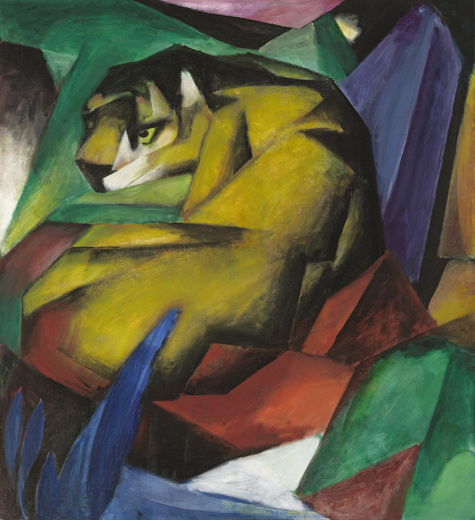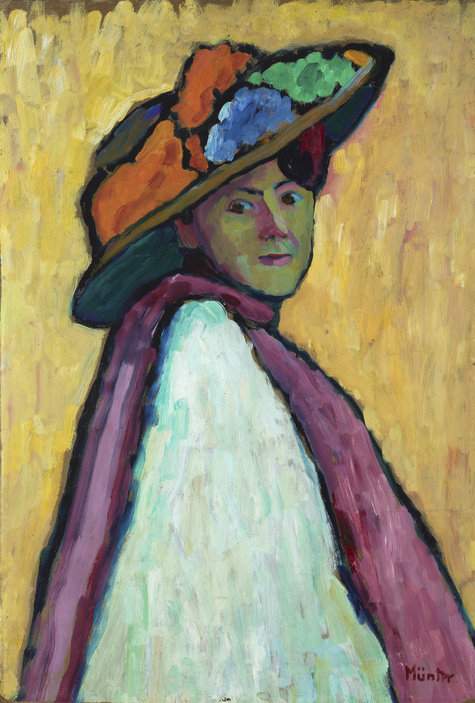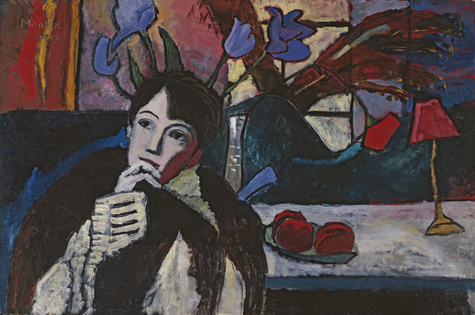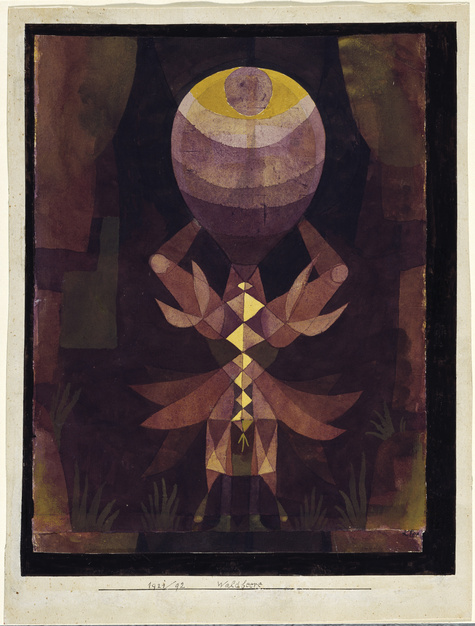The Blue Rider
Presentation of the collection –

The Lenbachhaus, Munich, has the world’s largest collection of art of the Blauer Reiter, one of Germany’s and indeed Europe’s most important groups of avant-garde artists in the early twentieth century. The core of this treasure consists of the generous endowment made by the painter Gabriele Münter, who was Wassily Kandinsky’s companion until 1914.
On occasion of her eightieth birthday in 1957, she bequeathed more than a thousand works by the Blauer Reiter to the Lenbachhaus, among them ninety oil paintings by Kandinsky as well as around 330 watercolors and drawings, sketchbooks, and reverse glass paintings by the artist and his printed oeuvre. The bequest also included more than twenty-five paintings by Münter herself and works by other eminent artists such as Franz Marc, August Macke, Paul Klee, Alexej von Jawlensky, and Marianne von Werefkin. With Gabriele Münter’s extraordinary donation in 1957, the Städtische Galerie im Lenbachhaus had a collection worthy of a world-class museum.
In 1965, the singular ensemble of the Gabriele Münter Foundation, which offers visitors an unmatched opportunity to study and experience the art and history of the Blauer Reiter, was augmented by a second important endowment. Inspired by Münter’s example, the heirs of Bernhard Koehler donated chief works by Franz Marc and August Macke. Bernhard Koehler Sr., a wealthy Berlin-based industrialist, was the uncle of Macke’s wife; he had not only bought numerous works produced by the artists of the circle starting in 1910, but also given financial support to the exhibitions of the Blauer Reiter and the publication of its almanac in 1911 and 1912. For the Lenbachhaus, these two endowments moreover opened up national as well as international perspectives to which the collection has remained committed to this day with its emphases in contemporary art, its exhibition programming, and its global contacts.
With the artists’ association Die Brücke in Dresden and Berlin, the Blauer Reiter circle in Munich is part of the most important movement toward artistic innovation in twentieth-century German art. In contrast with the figurative expressionism of the Brücke artists, the Blauer Reiter circle, starting in 1908, developed a distinctive radiantly colorful, expressive, and sometimes abstract formal vocabulary; unified by the artists’ shared belief in a “spiritual” dimension of art, it accommodated diverse forms of expression. Founded in 1911, the Blauer Reiter was accordingly a cooperative undertaking founded on the principle of diversity and sustained by the artist’s unique personalities. In this openness lay its modernity, which is as compelling and contemporary now as it was then. Over the past decades, the Lenbachhaus has steadily worked with its Blauer Reiter collection; an important part of this work consisted in the groundbreaking series of artist’s retrospectives launched in the 1980s, which were considerably amended and enlarged upon starting in 1990:
- Alfred Kubin (1990)
- Gabriele Münter (1992)
- Adriaan Korteweg (1993)
- Albert Bloch (1997)
- Das bunte Leben, Wassily Kandinsky im Lenbachhaus
- [Vassily Kandinsky, A Colorful Life] (1995)
- Der Blaue Reiter und das Neue Bild (1999)
- Alfred Kubin—The Lithographic Oeuvre (1999)
- Gabriele Münter, The Printed Oeuvre (2000)
- Franz Marc (2005)
- Gabriele Münter, Die Reise nach Amerika, Photographien 1899-1900, Die Jahre mit Kandinsky, Photographs 1902-1914 (2006/07)
- Kandinsky. Absolute, Abstract (2008–2010), in collaboration with the Centre Pompidou, Paris, and the Guggenheim Museum, New York
At the same time, the Lenbachhaus always also explored new ways of displaying the permanent Blue Rider collection. In 1992, the department ventured an experiment that was revolutionary at the time: instead of the "white cube," the predominance of white walls in exhibition halls and display cabinets, which had been the standard form of museum presentation for decades, the museum opted in favor of colorful walls. Works by Kandinsky were hung on dark red or stone-gray walls; Marc’s and Macke’s, on yellow; the Murnau landscapes, on blue. The colorful accents on the Lenbachhaus’s walls were based on extensive research, which is summarized in the documentation Farbige Wände: Zur Gestaltung des Ausstellungsraumes von 1880 bis 1930 . The Lenbachhaus’s example has been widely imitated: nowadays, the show is rare that is not presented on colorful walls. Between 2006 and 2009, we added another experiment: four artists—Franz Ackermann, Thomas Demand, Olafur Eliasson, and Katharina Grosse—were invited to engage in creative ways with one of the rooms dedicated to the various artists of the Blauer Reiter. Ackermann, working in the Marc room, created a wall painting with crystalline forms; Demand covered the Macke room with a photographic wallpaper based on an ivy leaf pattern he had reconstructed out of paper; Eliasson had a "white cube" restored in which works by Kandinsky were then presented bathed in situational lighting that shifted between locations and over time; and Grosse redesigned the Jawlensky room with colorful graffiti on the walls and floor.
Between 2009 and 2013, the Lenbachhaus was temporarily closed for general renovation and the addition of a new wing designed by Foster + Partners. During this time, parts of the Blauer Reiter collection went on tour: In 2009, when the museum was first closed, a selection of the best-known Blauer Reiter pictures were sent on loan to the Museum Frieder Burda, Baden-Baden, where the Lenbachhaus presented the core of its collection to audiences in southwest Germany and the neighboring areas of France. The exhibition, whose motto was Friends, Paths, Aspirations, was conceived and designed by the Lenbachhaus, which also produced the catalogue, and focused on the web of relationships between the group’s leading personalities: Kandinsky, Marc, Macke, Münter, and Jawlensky.
In 2010, the most extensive selection from the Blauer Reiter collection ever to leave the Lenbachhaus, comprising more than 120 works, including precious works on paper by Kandinsky, Macke, and Klee, was sent on loan to the Gemeentemuseum, The Hague. The Gemeentemuseum conversely loaned the Lenbachhaus a no less eminent selection of art for a show on Piet Mondrian and De Stijl. Both exhibitions — Kandinsky en Der Blaue Reiter [Kandinsky and the Blue Rider] and Mondrian und De Stijl [Mondrian and De Stijl] — were realized at the site of their presentation by the directors and curators of the respective museum. The research focus of the Blauer Reiter show in The Hague was on the reception of Kandinsky’s work in the Netherlands since 1912, his ties to theosophy, and his interest in the art of children.
In 2010–2011, we produced the exhibition Der Blaue Reiter: Aquarelle, Zeichnungen und Druckgraphik aus dem Lenbachhaus [Der Blaue Reiter: Watercolors, Drawings, and Prints from the Lenbachhaus], which first went on display at the Kunstbau, Munich. The exhibition and catalogue offered the first comprehensive presentation of the collection’s holdings of works on paper by the Blauer Reiter artists Albert Bloch, Heinrich Campendonk, Robert Delaunay, Alexej von Jawlensky, Eugen von Kahler, Paul Klee, Else Lasker-Schüler, August Macke, Franz Marc, Alexander Sacharoff, Eduard and Elsa Schiemann, and Marianne von Werefkin, complemented by a careful selection of pieces by the group’s leading artists, Wassily Kandinsky and Gabriele Münter, as well as Alfred Kubin; the Lenbachhaus holds hundreds of sheets by these artists. The exhibition then traveled to the Albertina, Vienna, which conversely loaned the Lenbachhaus an outstanding selection of works on paper by Egon Schiele.
In 2010–2011, the exhibition Kandinsky and the Blue Rider from the Lenbachhaus, Munich went on tour to four stations in Japan: the Mitsubishi Ichigokan Museum, Tokyo; the Aichi Prefectural Museum of Art, Nagoya; the Hyogo Prefectural Museum of Art, Kobe; and the Yamaguchi Prefectural Art Museum, Yamaguchi. The show featured a selection of sixty well-known Blauer Reiter paintings as well as documents, photographs, and a few works by Franz von Lenbach and Franz von Stuck that illustrated the historical context and the presentation at the museum for Japanese audiences. The catalogue was designed in collaboration between the team at the Lenbachhaus and Japanese colleagues.
In 2011–2012, the same selection of works by Kandinsky and the Blue Rider was on display at a final venue: the Pushkin Museum, Moscow. Once again, a catalogue was produced in collaboration between the Lenbachhaus and our Russian colleagues. The Moscow show focused on Kandinsky’s life and work: during the Soviet era, from 1917 to 1989, his art was proscribed in Russia, and audiences had no opportunity to see his pictures. After 1989, the Tretyakov Gallery, also in the Russian capital, brought his works back from storage for a grand international retrospective before integrating them into its permanent modern art exhibition. The Pushkin Museum itself, however, has no works by Kandinsky, whence the particular accent on this leading Russian Blue Rider artist.
The new presentation at the Lenbachhaus devotes the entire third floor to the Blauer Reiter. Hundreds of thousands of visitors a year will once again have access to the world-famous collection in a presentation that combines overwhelming abundance with focused selection. Among the art on display will be chief works by the Blauer Reiter such as Kandinsky’s "Impression III (Concert)," Marc’s "Blue Horse I," Münter’s "Still Life with Saint George," Macke’s "Promenade," and Jawlensky’s "Portrait of the Dancer Alexander Sacharoff."






